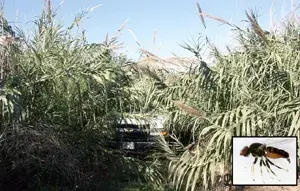 (May 2007) Several hundred years ago, a particularly noxious weed called Carrizo cane hitched itself a ride from Europe’s Iberian Peninsula to the U.S.-Mexico border, and there it has flourished very well ever since. Today, the weed stands as both a nuisance to the region and a threat to homeland security.
(May 2007) Several hundred years ago, a particularly noxious weed called Carrizo cane hitched itself a ride from Europe’s Iberian Peninsula to the U.S.-Mexico border, and there it has flourished very well ever since. Today, the weed stands as both a nuisance to the region and a threat to homeland security.
Also known as elephant grass, giant reed, or—scientifically—Arundo donax L., Carrizo cane is a ubiquitous, determined weed that chokes waterways, erodes banks and water canals, damages bridges, and inhibits biodiversity. It spreads quickly, with underground rhizomes shooting upwards of 18 feet, and it provides potentially dangerous illegal aliens with the cover they need to slip into the United States from across the Rio Grande. It is a major impediment, in particular, to DHS-led operations between Laredo and Del Rio, Texas—overrunning border access roads, reducing visibility, and hiding illegal activities.
But all that is about to change … perhaps with a fly, perhaps with a wasp, perhaps with a parasitic insect called a scale. The Department of Homeland Security (DHS) Science and Technology Directorate (S&T), through the Border and Maritime Security Division, is sponsoring research to identify natural predators of the related Carrizo reed in Europe and to introduce them here to do battle. Three biological control agents are being considered: Tetramesa romana, known as Arundo wasp, lays its eggs in the cane stem, where the larvae cause lethal galls to form in the stem; larvae of Cryptonevra, known as Arundo fly, kill new plant shoots of the cane; and Rhizaspidiotus donacis, or Arundo scale, feeds on the rhizomes.
“This cane presents many problems for our Border Patrol agents, and they’ve asked for help,” says Gerry Kirwin, program manager for biological control of the cane. “Their remote video surveillance cameras cannot penetrate it, and it allows smugglers to cross the Rio Grande and approach agents virtually undetected.”
The biological control program of the Carrizo Reed has many components, including a quarantined evaluation of agents to make sure our own native ecology is protected. The goal is to properly evaluate these agents, to select and gain approval for them, and to conduct a pilot release program on the Rio Grande near Laredo. If the pilot test is effective, a larger mass-breeding and mass application program could be implemented.
To request more information about this story, please e-mail st.snapshots@hq.dhs.gov.
